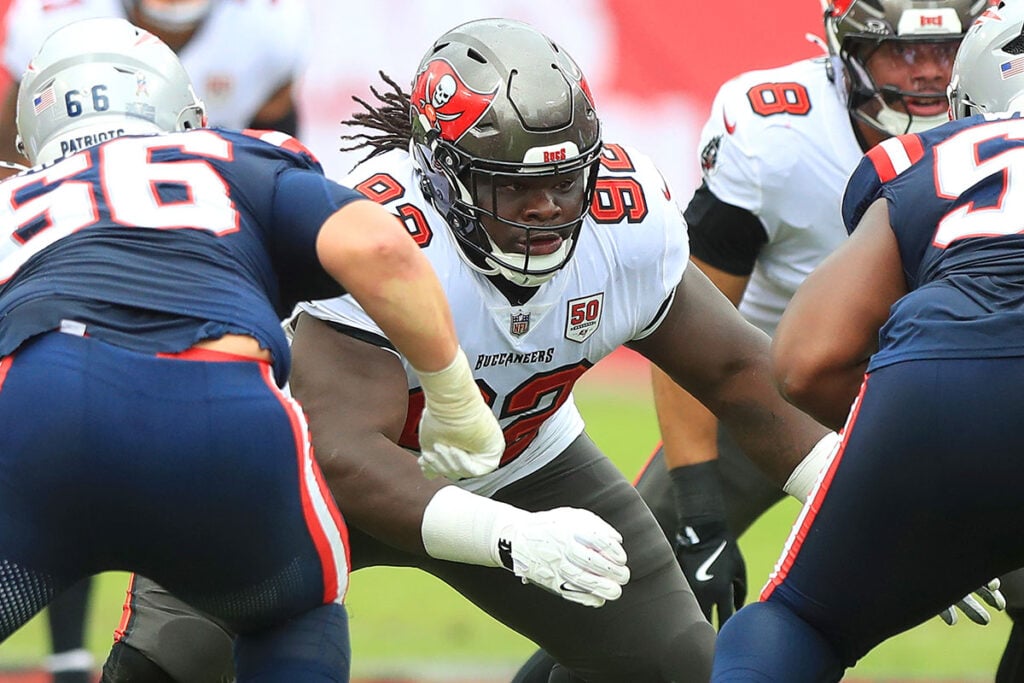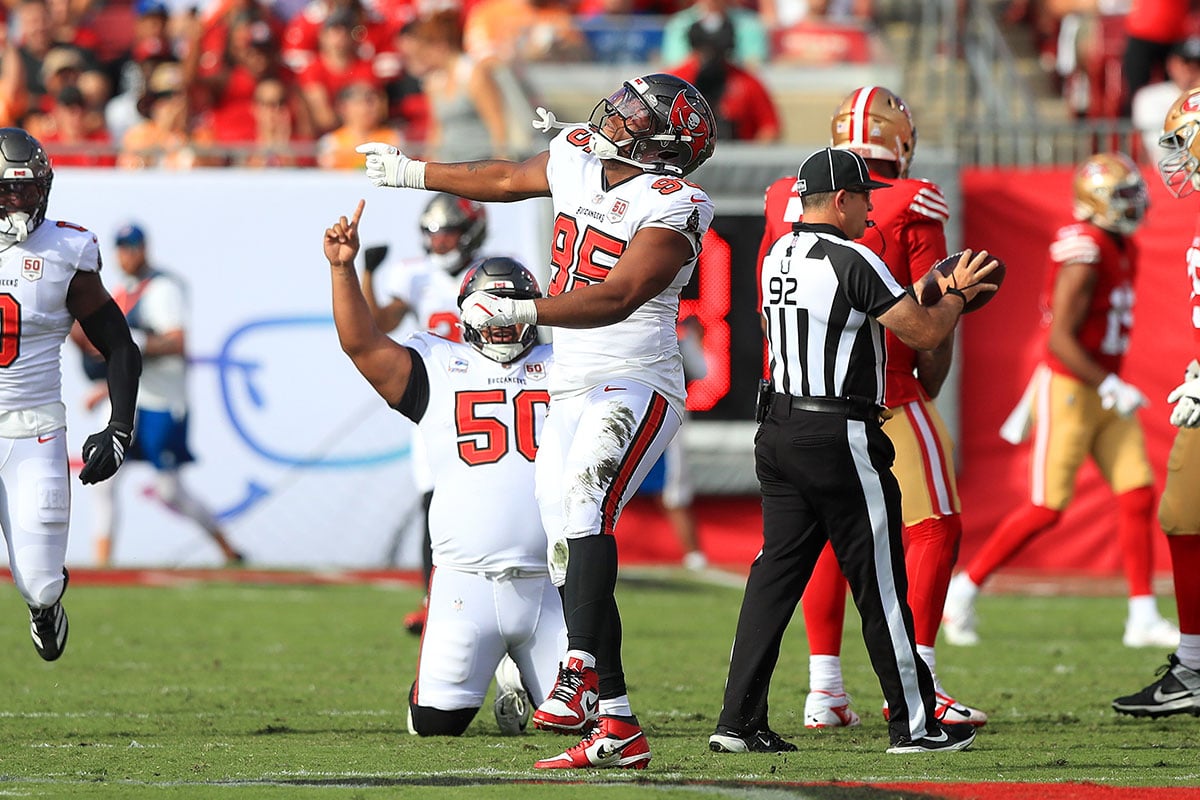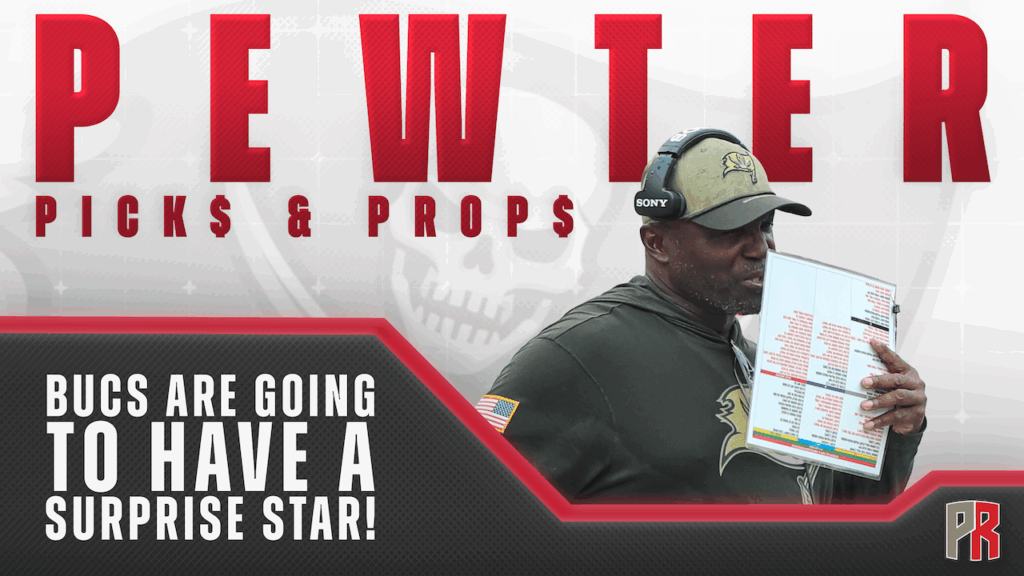Rookie defensive tackle Elijah Roberts was supposed to be a developmental project. The Bucs undoubtedly loved his talent. It’s why they selected him in fifth round of the 2025 NFL Draft.
But they were also asking him to switch positions. Roberts played defensive end in college at Southern Methodist University. There he racked up 111 pressures and 17 sacks from 2023 to 2024 per Pro Football Focus.
The Bucs thought Roberts profiled best as an interior lineman at the pro level and have been working with him in that capacity since rookie training camp. The development path looked clear and responsible. There was a roster spot for him where he could play limited snaps as a late-down pass rusher. But he was most likely going to be DT5 behind veterans Vita Vea, Calijah Kancey, Logan Hall and Greg Gaines.
But then injuries happen and plans change.
Kancey, who was poised for a breakout season, was lost for the season to a pectoral injury that required surgery, and the Bucs needed pass rush juice to go alongside Vea. Gaines is a run-stuffer who has never been a consistently high-quality pass rusher. And while Hall was billed as such when the Bucs drafted him with their first pick of the 2022 NFL Draft at the top of the second round, he’s never developed that part of his game to be considered a true threat.
Elijah Roberts’ Quick Ascension To Bucs Starter
Through the first two weeks of the 2025 season, Elijah Roberts played 5% of team’s total interior defensive snaps. Since then, that number has jumped to 22%. His snap count among the defensive tackle group over this stretch is second only to Vita Vea, as he has slightly out-snapped Logan Hall, who is in a contract year.
The main reason for this is that Roberts most closely replicates the pass rush production that Calijah Kancey offered to the defense. His 8.2% pressure rate on the season is noticeably higher than Hall’s 6.5% and Greg Gaines’ 4.2%. None of those players is at the caliber of Kancey’s 10.9%, but Roberts has shown the ability to win one-on-ones up front in the trenches.

Bucs DT Elijah Roberts – Photo by: USA Today
The way he wins is much different than Kancey as well. Kancey’s movement skills are special, as he can beat offensive linemen to spots, shoot gaps, and generally just win with suddenness, speed and flexibility. Roberts, despite being undersized at 6-foot-4, 295 pounds, uses powerful hands and a quick lateral step in concert to create space for him to penetrate on second movement. The difference can be seen in their get-offs. Per Next Gen Stats, Kancey averaged a 0.86 second get-off while Roberts is just under a second at 0.98 seconds.
Head coach Todd Bowles has been able to keep up the pressure and sack rates without Kancey, his young star defensive tackle, in part, due to Roberts’ emergence. And for a fifth-round pick to step in as he has, and help keep the standard for such a successful pass rush, is nothing short of amazing. But the areas of development the team wanted to work with him on are still weak spots in his game.
Becoming More Well-Rounded
Elijah Roberts has not figured out how to consistently anchor as a run defender against offensive linemen who often outweigh him anywhere from 15-40 pounds. And when he faces a double team, he can get blown off the line of scrimmage vertically, leaving his teammates in tough positions to make up for it. This issue was contributory to two different explosive runs the Bucs defense has given up this year – a 78-yard touchdown score by Jahmyr Gibbs in Week 7 against the Lions, and a 55-yard score by Patriots rookie rusher TreVeyon Henderson in Week 10.
Roberts has improved from his college tape and preseason showing in understanding his run fits and how to contend with NFL run games while playing inside. But it’s still a work in progress. His signature club move requires him to become more upright and exposes his chest. It puts him in a disadvantageous position to try and anchor down and hold the point of attack. That’s something opposing teams are noticing and attacking. The league is challenging Roberts to defend duo, and so far, he has struggled to respond.

Bucs DT Elijah Roberts – Photo by: Cliff Welch/PR
Advanced metrics confirm the story the tape is telling. His average depth of tackle (2.0) is second-worst among the six interior defensive linemen with at least 20 run defense snaps who have played for Tampa Bay this year per Pro Football Focus.
This is obviously something the team is working with him on behind the scenes, but there is only so much growth that can be expected on the fly. Remember, he is transitioning from playing almost exclusively at defensive end in college to defensive tackle in the NFL, which is incredibly hard to do – and do well. Still, Roberts has two sacks on the season, including the lone sack of New England quarterback Drake Maye in Week 10.
In the meantime, it may be wise for Bowles and the Bucs to be more strategic in their deployment of their young defensive tackles. Roberts has replaced Gaines as the starting end flanking Vea in base sets. He has also replaced Hall as Vea’s primary running mate in nickel defense. The team could lean further into a defensive rotation to exploit the best traits of both him and fellow rookie Elijah Simmons, who is a big run-stuffer at 6-foot-1, 334 pounds.
Getting The Most Out Of Multiple Parts
Elijah Simmons, a massive human being, has played extremely well in limited snaps this season. His -1.0 average depth of tackle is second only to Calijah Kancey’s -2.0. But like Elijah Roberts’ pass rush wins being vastly different than Kancey’s, Simmons drives offensive linemen into running backs behind the line of scrimmage rather than flying by them as a gap shooter. Simmons can play both the nose tackle as well as the 4i on base sets and frees Vita Vea up to move around the line and wreak havoc.

Bucs DT Elijah Simmons – Photo by: Cliff Welch/PR
It could become a best of both worlds if Simmons takes some of Roberts’ early down snaps to help stuff the run as Bowles wants to do and back offenses up into third-and-long. At that point, Roberts can come in and focus on winning as a pass rusher with his devastating club/rip.
The Bucs are one of the best defenses in the league when they can control explosives. In two of their past three games, they have struggled to limit the big-time runs and Roberts has been a consistent part of some of those busts. He’s absolutely a crucial part of the team’s success going forward, especially as a pass rusher, but play-time management can help maximize his strengths and minimize his deficiencies until he can level up the less-polished portion of his game.
And in the process, the Bucs run defense can find a level of consistency they have been lacking this season.
Josh Queipo joined the Pewter Report team in 2022, specializing in salary cap analysis and film study. In addition to his official role with the website and podcast, he has an unofficial role as the Pewter Report team’s beaming light of positivity and jokes. A staunch proponent of the forward pass, he is a father to two amazing children and loves sushi, brisket, steak and bacon, though the order changes depending on the day. He graduated from the University of South Florida in 2008 with a degree in finance.



